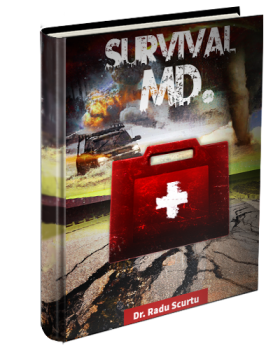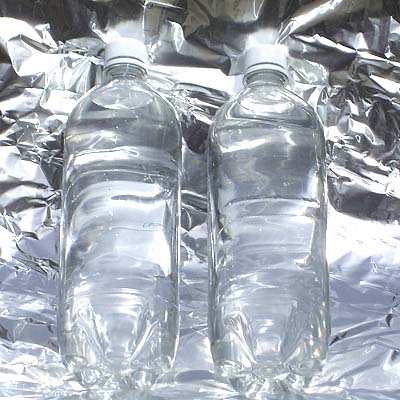Did you know that solar radiation from the sun can purify water (disinfect) and make it safe for drinking from harmful bacteria?
While so often we hear or read about the bad things that the sun is capable of doing to us, we should also know that some of the same energy from the sun can be harnessed for doing good. A few good examples include solar electric panels, solar hot water panels, and solar ovens.
Well here is one more good example. Harnessing the solar energy from the sun to purify (disinfect) water from a lake or stream into safe drinking water. It is much simpler than you may think. Here’s how…
UV-A rays from the sun, (Ultraviolet-A, longwave, 315-400 nm), will terminate harmful bacteria, parasites, and viruses in water, given enough sun exposure.
A clear plastic bottle filled with water, exposed to the sun for 6 hours will make the water safe to drink (see the caveat list). In fact, the effectiveness of terminating harmful bacteria is an amazing 5-Nines, that is, 99.999 percent!
List of germs that are terminated from UV-A sunlight exposure at 6 hours
- Bacteria – Escherichia coli
- Bacteria – Vibrio cholera
- Bacteria – Salmonella
- Bacteria – Shigella flexneri
- Bacteria – Campylobacter jejuni
- Bacteria – Yersinia enterocolitica
- Virus – Rotavirus
- Parasites – Giardia
- Parasites – Cryptosporidium (needs 10 hours exposure)
List of caveats to UV-A sunlight water purification
- This method kills germs. If the water is already contaminated with chemicals from pollution, the chemicals will remain.
- If the water is cloudy and dirty, it should be filtered first to allow the UV-A rays to effectively penetrate into the water.
- The plastic water bottle should be no bigger than 2 liters. In moderately cloudy water, UV-A will lose 50 percent effectiveness at a depth of 10 mm (about 0.5 inch), whereas UV-A will only lose 25 percent effectiveness at a depth of 10 mm in clear water. Just use a typical size soda bottle or water bottle.
How to purify water with sunlight
The recommended bottle to use is a “PET” bottle. It is very common and is typically used for soda or other soft drinks.

PET, PolyEthylene Terephthalate, Recycle code #1 on bottom of bottle.
The bottle must not be colored. It must be a clear bottle. Again, it must be a clear plastic bottle. Not glass (glass blocks too much of the UV-A for this purpose).
The bottle must be clean. Common Sense.
Know your water source (as best you can)… if you believe it to be chemically toxic, don’t use it.
Fill the bottle with water. If the water is very cloudy, it must be filtered by first pouring through a cloth or such material to capture sediment.
Lay the bottle down in the sun. Do not stand them up. Ideally the bottles would by placed so that they face the the sun at a similar angle, to maximize the UV-A penetration.
Even better… lie the bottles on a reflective surface to increase the UV-A exposure using direct and reflected sunlight. This is not necessary, however it would shorten the required time and ensure optimum UV-A exposure.
If the sky is partly cloudy with only a few clouds, then 6 hours sunlight exposure will be enough. If the sky is half filled with clouds, or more, then 2 days will be required.
Note that the outdoor temperature does not matter, so long as the UV-A sunlight exposure has been 6 hours.
A few notes:
An excellent source for more information on this subject:
Swiss Federal Institute of Aquatic Sciences and Technology.For those that are concerned about using plastic, the WHO (World Health Organization) states that the limiting values (plasticizers) for drinking water are never exceeded when using PET bottles for this method.
Sediment or other particulate matter should be removed first by a filtering process.
Source: modernsurvivalblog.com
Other useful resources:
Survival MD (Best Post SHTF Medical Survival Guide Ever)
Blackout USA (EMP survival and preparedness guide)
Backyard Innovator (All Year Round Source Of Fresh Meat,Vegetables And Clean Drinking Water)
Conquering the coming collapse (Financial advice and preparedness )
Liberty Generator (Easy DIY to build your own off-grid free energy device)
Backyard Liberty (Easy and cheap DIY Aquaponic system to grow your organic and living food bank)
Bullet Proof Home (A Prepper’s Guide in Safeguarding a Home )
Family Self Defense (Best Self Defense Strategies For You And Your Family)
Sold Out After Crisis (Best 37 Items To Hoard For A Long Term Crisis)



I think I’m too much of a chicken to use this technic. I’d be afraid of algae growth or something.
If the zombies stole all my water filtration supplies, and this was the only method available, then count me in! We drank a lot worse looking water from the streams of Viet-Nam, and survived.